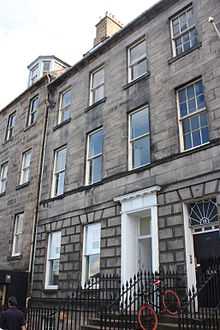James Jardine
James Jardine FRSE FSAScot (1776–20 June 1858) was a Scottish civil engineer, mathematician and geologist. He was the first person to determine mean sea level.[1]

Life
He was born in Applegarth, Dumfriesshire, on 30 November 1776, the son of a farmer. He was educated at Dumfries Academy and Edinburgh University. He studied mathematics under Prof John Playfair. He was a friend of Thomas Telford and they coloborated on several projects[2]
He built tunnels and bridges, including for the Innocent Railway, and built reservoirs including Glencorse, Threipmuir, Harlaw for Edinburgh, and Cobbinshaw for the Union Canal.
Following studies at the Firth of Tay, he was the first person in the world to calculate Mean Sea Level.
From 1796 to 1808 he lectured in Mathematics at Edinburgh University.[3]
From 1811 he began a series of harbour designs, beginning with Saltcoats. This was followed by Perth (1831), major extensions to Leith Docks (1835), and Eyemouth (1837).
In 1813 he received the commission to drain the final waters of the Nor Loch to create Princes Street Gardens, and the final waters of the Burgh Loch to create The Meadows both in Edinburgh.[4]
In 1819 he was appointed by the city to improve Edinburgh's water supply. He built a series of new reservoirs: Glencorse (1824), Threipmuir (1843), Harlaw (1848). Following this he was commissioned to undertake similar improvements in Perth, Dumfries and Glasgow. He re-engineered Loch Leven, reducing its water level by creating the Leven Cut, its first outlet. He did much of the engineering on the Union Canal, including creation of Cobbinshaw Reservoir as its water supply.[5]
From 1826 he worked on the Edinburgh and Dalkeith Railway line, creating its St. Leonards branch, now commonly called the Innocent Railway. This includes a remarkable tunnel under the souther edge of Arthur's Seat plus the Glenesk Viaduct. He then embarked on other, more northerly railway projects: Ardrossan (1827), Threave (1825), Inveralmond (1827).
He worked on several projects with his friend Thomas Telford, including provision of mathematical calculations to establish the required chain strength to hold the Menai Straits suspension bridge.
He was unsuccessful in his designs of Dean Bridge in Edinburgh and the City Observatory.[6]
He died at home, 18 Queen Street, one of the most prestigious addresses in Edinburgh. He had never married and had no children.
He is buried in Warriston Cemetery, in the upper section, on the main east west path near the old East Gate.
He is known to have trained the railway engineer Alexander Adie.[7]
References
- ↑ Waterston, Charles D; Macmillan Shearer, A (July 2006). Former Fellows of the Royal Society of Edinburgh 1783-2002: Biographical Index I. Edinburgh: The Royal Society of Edinburgh. ISBN 978-0-902198-84-5. Retrieved 10 February 2011.
- ↑ Scottish National Portrait Gallery, notes on display
- ↑ http://www.royalsoced.org.uk/cms/files/fellows/biographical_index/fells_indexp1.pdf
- ↑ https://books.google.co.uk/books?id=jeOMfpYMOtYC&pg=PA359&lpg=PA359&dq=james+jardine+engineer&source=bl&ots=aD9zWZ_f6b&sig=iEHnP0l21iY3aOjuZ0bts1tbgqU&hl=en&sa=X&ei=soIMVfrOB6Sa7gb4zYGYCQ&ved=0CDkQ6AEwBA#v=onepage&q=james%20jardine%20engineer&f=false
- ↑ http://www.scottish-places.info/people/famousfirst2497.html
- ↑ Buildings of Scotland: Edinburgh by Gifford McWilliam and Walker
- ↑ http://www.royalsoced.org.uk/cms/files/fellows/biographical_index/fells_indexp1.pdf